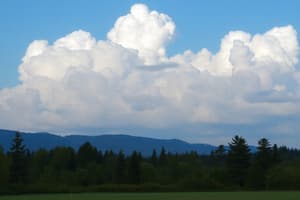Podcast
Questions and Answers
What is the main role of basal nuclei in motor control?
What is the main role of basal nuclei in motor control?
- Exciting muscle tone throughout the body
- Maintaining reflexes and automatic movements
- Inhibiting muscle tone throughout the body (correct)
- Controlling voluntary motor behaviors directly
What is the primary function of the thalamus in motor control?
What is the primary function of the thalamus in motor control?
- Receiving sensory feedback
- Positively reinforcing voluntary motor behavior (correct)
- Sending motor signals to muscles
- Inhibiting motor activity
What is the primary deficit in Parkinson's disease?
What is the primary deficit in Parkinson's disease?
- Lesions in the cerebral cortex
- Deterioration of the cerebellum
- Gradual destruction of neurons that release dopamine (correct)
- Destruction of neurons that release acetylcholine
What is the purpose of administering levodopa to Parkinson's disease patients?
What is the purpose of administering levodopa to Parkinson's disease patients?
What structure forms the walls of the third ventricular cavity in the diencephalon?
What structure forms the walls of the third ventricular cavity in the diencephalon?
What is the primary function of the thalamus in sensory processing?
What is the primary function of the thalamus in sensory processing?
What is the main role of the hypothalamus in the autonomic nervous system?
What is the main role of the hypothalamus in the autonomic nervous system?
Which structure is involved in emotional and behavioral patterns?
Which structure is involved in emotional and behavioral patterns?
What is the function of the hypothalamus in thermoregulation?
What is the function of the hypothalamus in thermoregulation?
Which of the following is NOT a function of the hypothalamus?
Which of the following is NOT a function of the hypothalamus?
Flashcards are hidden until you start studying
Study Notes
Basal Nuclei (Basal Ganglia)
- Several masses of grey matter located deep within cerebral white matter
- Important inhibitory role in motor control
- Inhibiting muscle tone throughout the body
- Maintaining proper muscle tone by balancing excitatory and inhibitory inputs
- Selecting and maintaining purposeful motor activity
- Suppressing useless or unwanted patterns of movement
- Helping monitor and coordinate slow, sustained contractions (especially related to posture)
Functions of Basal Nuclei
- Do not directly influence the efferent motor neurons
- Act by modifying ongoing activity in motor pathways
- Receive and send out large volume of information, as indicated by tremendous number of fibers linking them to brain regions
- One important pathway of strategic interconnections is a complex feedback loop, linking motor cortical regions, basal nuclei, and thalamus
Parkinson's Disease (PD)
- Gradual destruction of neurons that release neurotransmitter dopamine in the basal nuclei
- Characteristic motor disturbances:
- Rigidity: increased muscle tone
- Resting tremor: involuntary, useless or unwanted movements
- Slowness in initiating and carrying out different motor behaviors
- Standard treatment:
- Administration of levodopa (L-dopa): precursor of dopamine, can enter brain from blood
The Thalamus
- Located deep within the brain, near the basal nuclei
- A midline structure that forms the walls of the third ventricular cavity
- Consists of thalamus and hypothalamus
- Serves as "relay station" for preliminary processing of sensory input
- Screens out insignificant signals
- Routes important sensory impulses to appropriate areas of somatosensory cortex and other brain regions
- Helps direct attention to stimuli of interest along with brain stem and cortical association areas
Role of Thalamus in Motor Control
- Positively reinforces voluntary motor behavior initiated by the cortex
- Modulates activity initiated by the cortex
The Hypothalamus
- Collection of specific nuclei and associated fibers, that lie beneath the thalamus
- Important link between the autonomic nervous system and the endocrine system
- Integrating center for many important homeostatic functions
- Regulates the internal environment
- Functions:
- Controls body temperature (thermostat)
- Controls thirst and urine output
- Controls food intake
- Controls anterior pituitary hormone secretion
- Produces posterior pituitary hormones
- Controls uterine contractions and milk ejection
- Serves as major ANS coordinating center, affecting all smooth muscles, cardiac muscles, and exocrine glands
- Plays role in emotional and behavioral patterns
- Participates in the sleep-wake cycle
The Limbic System
- Functional system (not separate structure), consists of ring of forebrain structures surrounding brain stem and interconnected by intricate neuron pathways
- Includes portions of each of the following:
- Lobes of cerebral cortex (esp: limbic association cortex)
- The basal nuclei
- Hippocampus
- Thalamus
- Hypothalamus
- Amygdala
- Associated with:
- Emotions
- Behavior
- Motivation
Studying That Suits You
Use AI to generate personalized quizzes and flashcards to suit your learning preferences.




